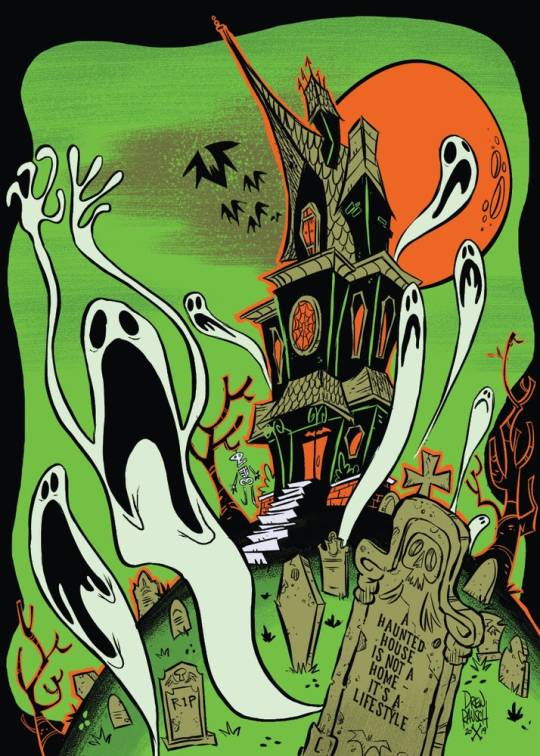#Drew Rausch
Text

Ghostface by Drew Rausch | Instagram
#scream#ghost face#scream 6#ghostface#scream vi#wes craven#jenna ortega#horror movies#slasher movies#horror art#halloween#horror#drew rausch
2K notes
·
View notes
Text

Edward Scissorhands, scetch by Drew Rausch for Kate Leth's comic book series
#tim burton#edward scissorhands#tim burton movies#kate leth#edward scissorhands comic#comic books#drew rausch#sketch#artwork
13 notes
·
View notes
Text
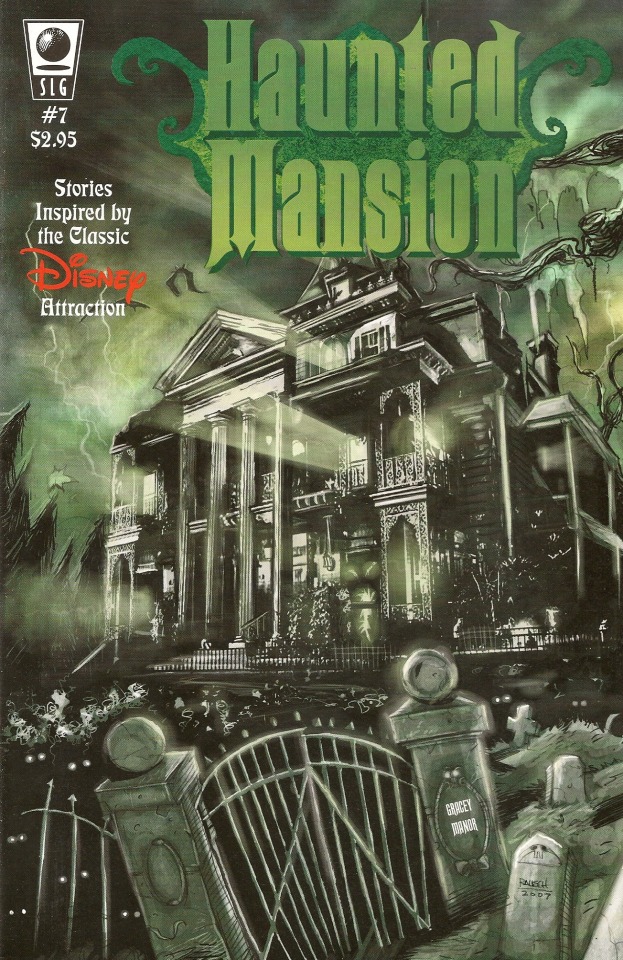
Haunted Mansion #7
#haunted mansion#gracey manor#haunted house#ghosts#graveyard#spooky#scary#Disney#drew rausch#slave labor graphics#comics#00s comics
7 notes
·
View notes
Text

Hey hey! This was the Black Phoenix Alchemy Lab story contest that used 15 of their Halloween scents as prompts. Mine was for a perfume called “Butterscotch and Gummy Candy Witch” (“Butterscotch brittle, burnt coffee beans, and sour apple gummies”). I am not the grand prize winner, but, looking at the results, I am the categorical Butterscotch Winner, and that is what I was shooting for.
The stories will be posted online “in the weeks to come,” so I’m not sure I should post it myself; I may ask if I can sneak it onto the Patreon.
222 notes
·
View notes
Text
The IZ comics have 15 extremely cool artists and here's a slight guide on how to identify them :3
Aaron Alexovich


- typically more dynamic and what i would describe as a “scratchy” artstyle
Issues: 1, 2, 3, 4, 5, 16, "Gir's Big Day", "Holiday Special", "The Dookie Loop Horror"
KC Green

- very silly and colorful style, creator of the “this is fine” comic/meme
Issues: 6, "Bitters and the Witch", 31
Dave Crosland

- more detailed style, similar to Alexovich but a bit cleaner
Issues: 7, 8, 9, 10, 21, "Invasion!"
Sarah Andersen
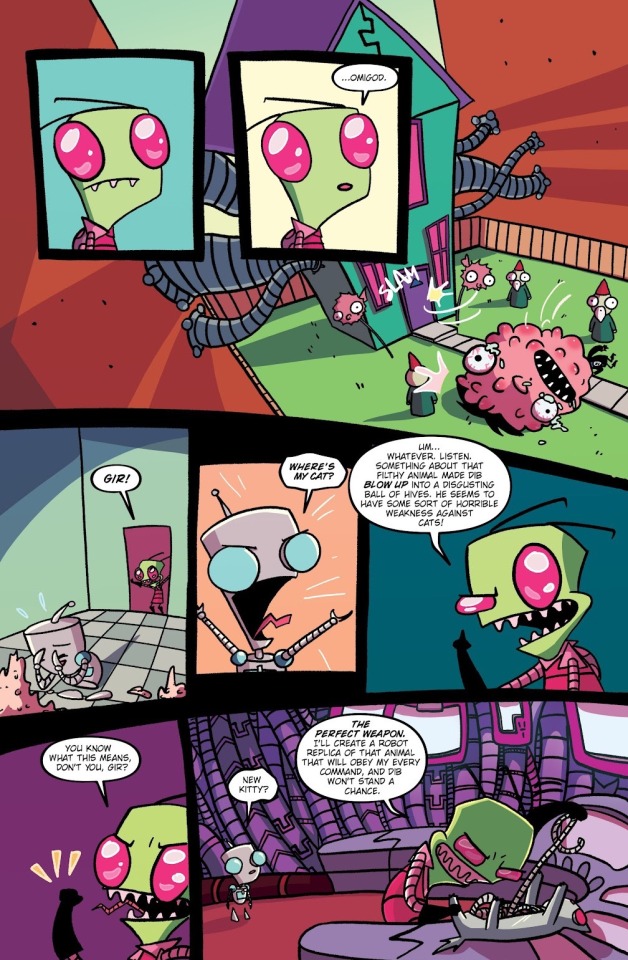
- another very silly style, though simpler than KC’s, creator of the “Sarah Scribbles” webcomics
Issue: 11
Warren Wucinich

- main artist and letter-er, typically stays fairly true to the original style though is a bit more round and curvier
Issues: 12, 13, 14, "Tales of Bitter", "The Evil Ms.Bitters", "Sweetheart Bitters", 17, 18, 19, 20, 22, 23, 24, 25, "Tales of Stuff What Did Not Happen", 42, 43, 44, 45, 50, "Dib's Dilemma"
Ian Mcginty

- fairly detailed and feels 3d at times, typically a cover artists (see here)
Issue: "Ms.Bitters' Bugs"
Sarah Graley
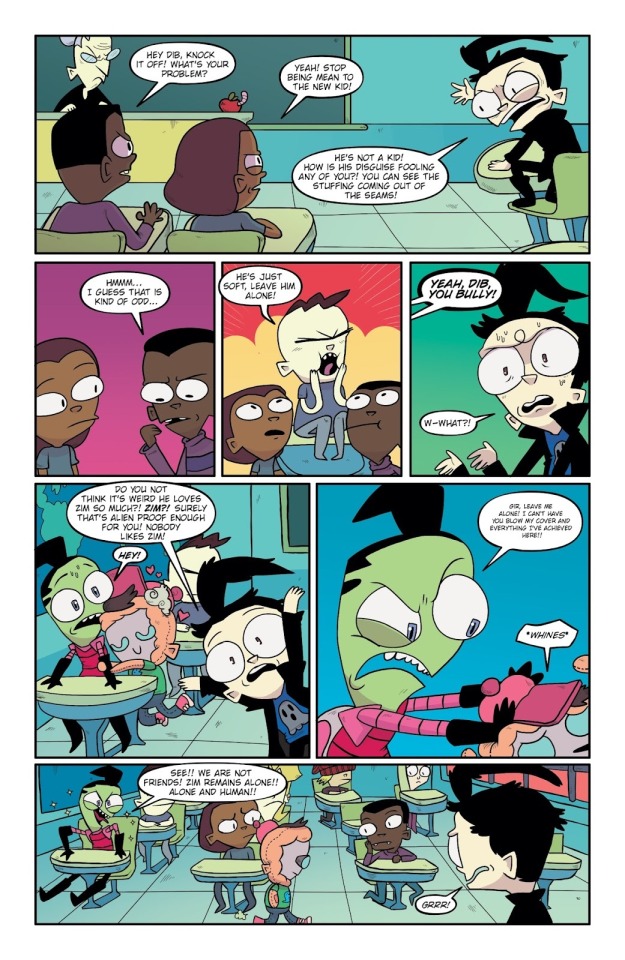
- ANOTHER silly style :3, this time more chibi than the others with flat colors
Issue: 26
Maddie C.

- i don’t know how to explain it but squishy, similar to the original style but instead of being mostly flat/sharp lines it’s more curvy (dib being the best example)
Issues: 27, 29, 30, 38, 46, 47, 48
Mady G

- sil,,,,ly, everything just flows together really nicely, very stretchy and expressive
Issue: 28
Kate Sherron
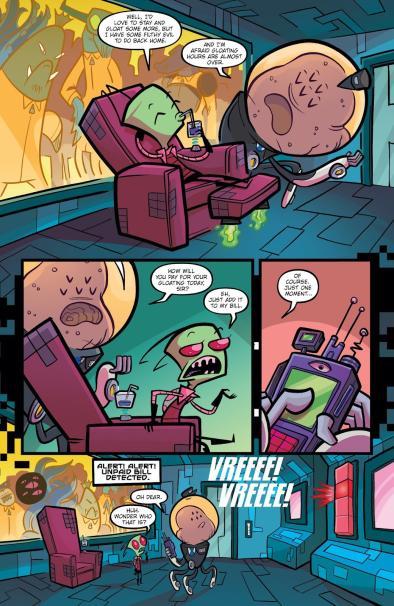
- similar to Wuncinich but id say its a bit more 2d
Issues: 32, 34, 35, 37, 39, "Sugar & Spice"
Meg Casey

- very expressive and curvy
Issue: 32, "ZIM No More", 49
Fred C. Stresing
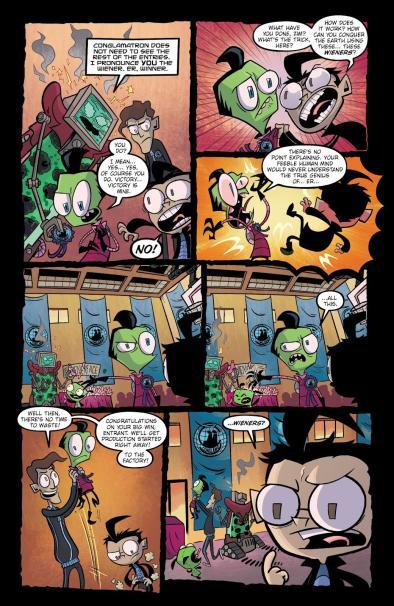
- tastes like mint ???????, i dunno how to explain it but very cool, i like zims faces
Issues: 33, "Warlocker ZIM", 49, "Zim's Greatest Plan"
Tait Howard & Matthew Seely
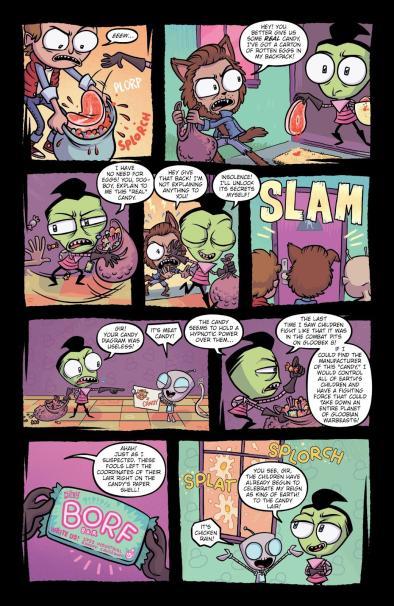
- uber chibi, very big eyes
Issue: 36
Dean Rankine
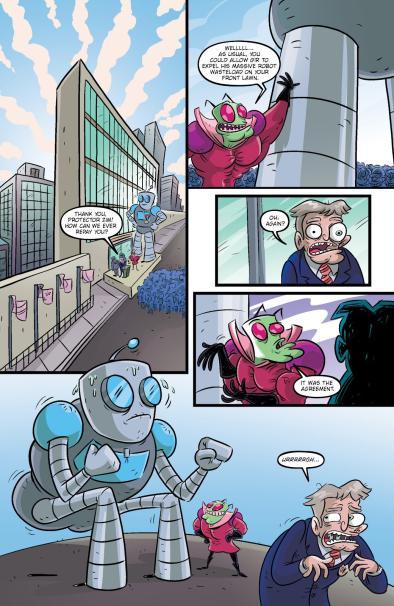
- only 2 pages so i cant really say much but cool
Issue: "SuperZIM"
Drew Rausch

- extremely shapely if that makes sense
Issue: 41
113 notes
·
View notes
Text

Drew Rausch in Curve (2015)
91 notes
·
View notes
Text
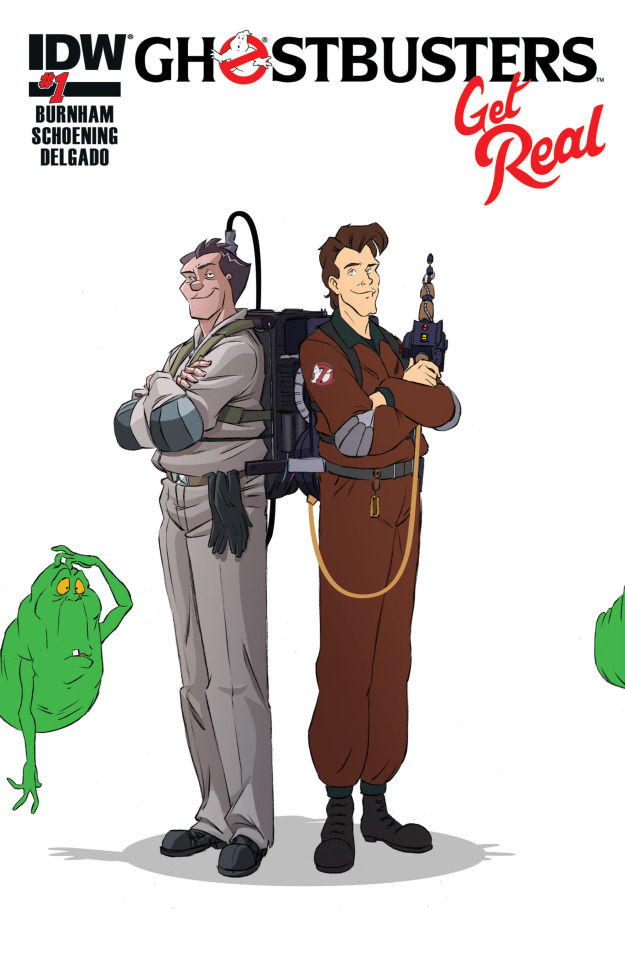


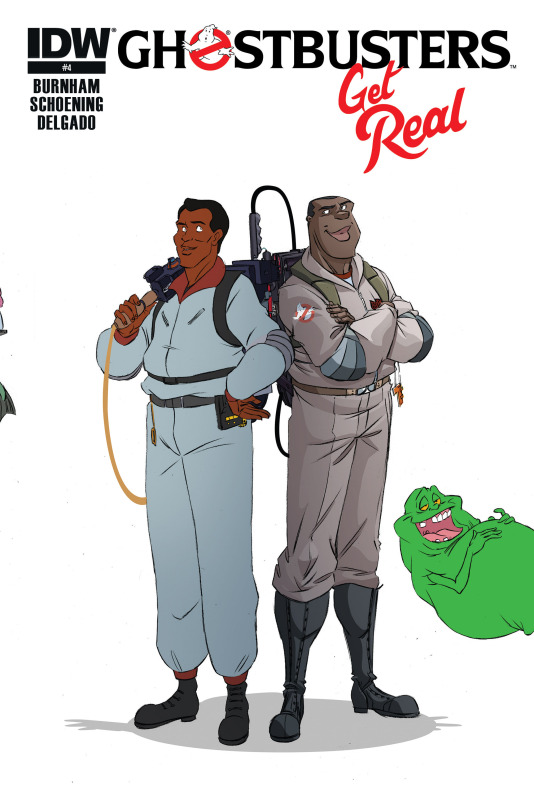

GHOSTBUSTERS: GET REAL #1-4, ANNUAL 2015
2015
By Erik Burnham, Tom Bancroft, Dan Schoening, Luis Antonio Delgado, Neil Uyetake, Erica Henderson, Evan Shaner, Joe Quinones, Chirs Uminga, Tom B. Long, Shawn Lee, Otis Frampton, Sara Richard, Sean Galloway, Drew Rausch, Matthew Dow Smith, Anthony Marques, Alex Deligiannis, Erik Evensen, Jeremiah Skipper, Ester Salguero, and Juanchoo

When the "Real Ghostbusters" get transported to the "real" Ghostbusters' Earth, the two teams will start investigating how to put things back to normal, and stop the God known as Proteus from capturing them.
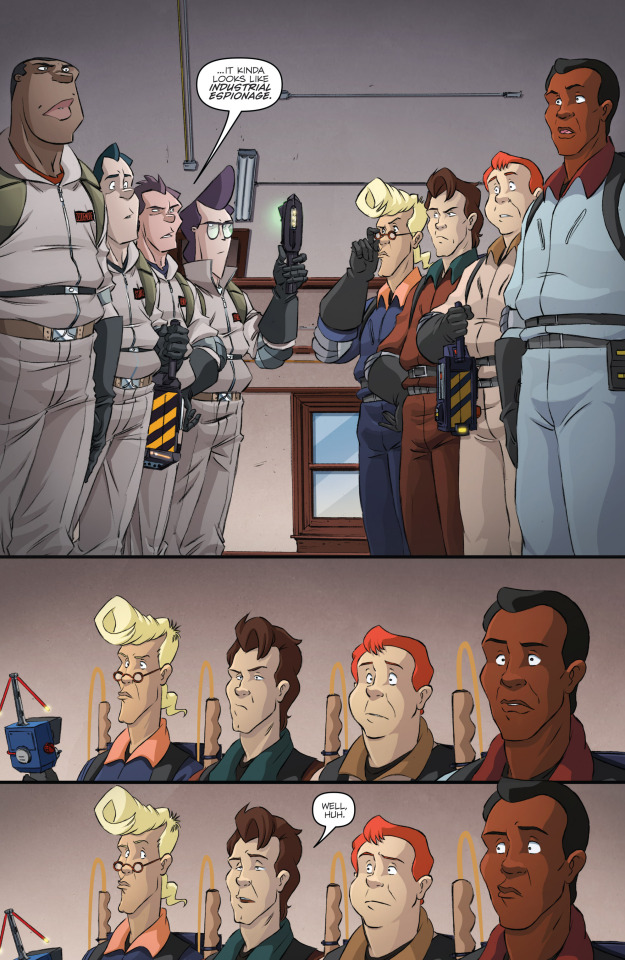
SCORE: 9
This one was an amazing read. Once more I am amazed on the versatility of Dan Schoening. They man can draw in any style!
But apart from the visuals, the story contains easter eggs beyond just the "real ghostbusters".


Now, to be fair. on that double splash page I had to read the wiki to figure out where some of those came from. But I was really surprised to see the Filmation Ghostbusters in the mix.
The story is simple enough, and fun. Now, I included the 2015 annual because, for some reason it tends to get bundled with this mini-series a lot. While it deals with the aftermath of "Get Real," it is not a continuation of the story.
The annual is a horror story (kind of), and it also introduced Samhain to the canon of the book.
Oh, and James Hong technically appears as the ghost from "Little trouble in Little China."
#comics#review#post modern age#idw publishing#ghostbusters#the real ghostbusters#slimer#dan schoening#evan shaner#2015#idw comics
39 notes
·
View notes
Text

Hashish in Berlin:
An Introduction to Walter Benjamin's Uncompleted Work On Hashish
Paper read at the Walter Benjamin Congress, University of Amsterdam, 1997: Scott J. Thompson.
*****
O braungebackne Siegessäule
mit Winterzucker aus den Kindertagen [1]
This motto beginning Walter Benjamin's Berlin Childhood Around the Turn of the Century and appearing in a slightly altered form in Berliner Chronik has its origins in Benjamin's experiments with hashish, as Gershom Scholem and the editors of Benjamin's Gesammelte Schriften have noted. The "golden leading strings" [2] of childhood and the attempt to recapture their magic are interlaced throughout Benjamin's writings and experimental notes on hashish, opium and mescaline. As he expressed it in the mescaline protocol recorded by Dr. Fritz Fränkel in Paris on 22. May 1934, "The first experience the child has of the world is not that the adults are stronger, but rather that it cannot conjure."[3] In Benjamin's novella "Myslowitz - Braunschweig - Marseilles: Story of a Hashish Rausch" (1930), the narrator's hashish vision transforms a man in a restaurant into the image of a young boy in an Eastern European town. [4] In the essay "Hashish in Marseilles" (1932), a young boy on an electric tram is transformed into the sad child, Barnabus, from Kafka's The Castle. [5] In "Crock Notes" (1932), the opium smoker and hashish eater are said to "playfully exhaust those experiences of the ornament which childhood and fever made us capable of observing." [6] In the protocol to the hashish experiment with Gert and Egon Wissing in March 1930, Benjamin recorded the following:
I was not very attentive to what Egon said because my hearing immediately converted his words into the perception of colorful, metallic glitter which coalesced in patterns. I made this understandable to him by comparing it to the knitting patterns which we loved as the beautiful colored plates in Herzblättchens Zeitvertreib [Darling's Diversions] when we were children. [7]
In a more recreational experiment with the Wissings on 7. June 1930, Benjamin saw Gert transformed into "a slender boy in black attire." [8] When Egon Wissing supervised Benjamin's experiment with hashish and the opiate Eucodal on 7. March 1931, he noted that "toys or colorful children's pictures thrust themselves to the foreground again and again." [9] In the session of 18. April 1931, supervising doctor, Fritz Fränkel, noted Benjamin's extremely childlike sensitivity to color and wordplay, particularly his "remarkable number of diminutives." [10]
In his attempt to regain the child's magical power of conjuring by availing himself of Dr. Ernst Joël's invitation to become a test subject in a series of loosely monitored hashish experiments, Benjamin was able not only to independently evaluate the findings of Baudelaire's Artificial Paradise, which he told Ernst Schoen in 1919 would be required to appreciate the book, [11] but was also able to explore that root of his philosophical intentions, which Theodor W. Adorno has described as an ability "to render accessible by rational means that range of experience that announces itself in schizophrenia." [12] In his essay "A Portrait of Walter Benjamin," Adorno drew attention to the concept which unites the magic of childhood with "mental derangement," when he wrote that "The rebus is the model of [Benjamin's] philosophy." [13] The playful disorientation of the rebus and the delight in the sudden spark that ignites the mind with its solution are keys to Benjamin's concept of "profane illumination." Given Benjamin's mania for collecting children's books and books by the "mentally deranged," to which Scholem has attested in his essay "Walter Benjamin," [14] it is logical that he would have taken advantage of an opportunity to explore substances the experimental value of whose attendant rausch was described by his old acquaintances, Ernst Joël and Fritz Fränkel, in their article "Der Haschisch-Rausch" in the following manner:
Without proposing a blanket identification of spontaneous psychotic episodes with the phenomena observed in these experiments, we nonetheless maintain that an experimental way of penetrating abnormal states exists here, which allows us to investigate how far the individual can deviate from the norm, and to determine which psychotic symptoms in general are within the realm of the normal individual. The rausch provides a remarkable yield of sympathetic understanding for pathological symptoms (compulsion, schizoid behavior, delusions, incoherence, etc.). One acquires a new understanding for the mythic and the mystical. As for the alterations of particular qualities or the lack of such alteration, first we must identify the qualities in the norm, if the conditions of normal psychic processes are to be disclosed by pathological modification. [15]
Though they do not employ the term in their article, the concept of the psychotomimetic, a substance the ingestion of which is said to imitate or simulate a psychosis, supplies the operative paradigm in Joël and Fränkel's "experimental psychopathology," which they understood as both an attempt at "a total comprehension of altered psychic life" [16] and as a necessary corrective to the mechanistic psychopharmacology of Emil Kraepelin's school. It is important that we understand Joël and Fränkel's theoretical presuppositions if we are to bring an informed reading to Benjamin's experimental protocols and the extant writings which testify to what remains of that uncompleted book on hashish, once described by Benjamin in a letter to Scholem on 26. July 1932 as "ein höchst bedeutsames Buch" ["a truly significant book"]. [17]
In his pathbreaking book Du Hachich et de l'Alienation mentale [Hashish and Mental Illness] (1845), Jacques-Joseph Moreau (de Tours) [1804-1884], the doctor who introduced hashish to Charles Baudelaire and the Club des Haschischins, suggested that psychiatry could benefit by comparing hashish experiments with the symptoms of the mentally ill. [18] This idea was adopted by Emil Kraepelin (1855-1926), father of psychopharmacology, when he called rausch "Irresein im kleinen" ["derangement in miniature"]. [19] The Kraepelinian method however, according to Joël and Fränkel, failed to comprehend the entire human being, because it mechanistically severed partial functions of the psychic life, which were then altered by psychopharmaka and subjected to behavioristic testing. In this important respect, Jöel and Fränkel's critique of Kraepelin was related to Benjamin's critique of the Kantian concept of experience.
In his early treatise "On the Program of the Coming Philosophy" (1917), Benjamin had called into question the Kantian concept of experience based on Newtonian physics, describing it as "view of the world of the lowest order." [20] Against Kant's Enlightenment mythology, Benjamin offered anthropological and psychological evidence of alternative realities outside the Kantian purview.
We know of primitive peoples of the so-called preanimistic stage who identify themselves with sacred animals and plants and name themselves after them; we know of insane people who likewise identify themselves in part with objects of their perception...we know of sick people who relate the sensations of their bodies not to themselves but rather to other creatures, and of clairvoyants who at least claim to be able to feel the sensations of others as their own. [21]
The cognizing subject of Kantian philosophy was called "a type of insane consciousness." [22] Against the Enlightenment worldview of the Protestant burgher, Benjamin posited a coming philosophy which would reclaim the cosmic rausch possessed by the human being of antiquity. In his later essay "Surrealism: The Last Snapshot of the European Intelligentsia" (1929), this cosmic rausch and its materialist, anthropological "profane illumination" were to be appropriated by the proletariat in the coming seizure of power.
Some scholars have seized upon the Surrealism essay to downplay Benjamin's interest in psycho-pharmaca. The concept of "profane illumination" is stressed as an awakening from a rausch, which is all-too-often characterized as a "narcotic trance," [23] despite the fact that cannabis and mescaline are not narcotic. The "profane illumination" of the rebus, however, presupposes an initial disorientation and sense of being puzzled. The problem with taking Benjamin's Surrealism essay as a definitive statement on rausch is that in so doing we overlook the fact that most of Benjamin's hashish, opium and mescaline experiments were written after 1929. Protocols V - X were conducted between March 1930 and May 1934. In November 1930, "Myslowitz - Braunschweig - Marseilles" appeared in the journal Uhu. During the spring of 1932, the more theoretical Crock Notes were written in Ibiza, and in December 1932, "Hashish in Marseilles" appeared in the Frankfurter Zeitung. Then there are the passages on hashish in the Passagen-Werk. Nor may we forget that Benjamin had first told Scholem that "even my experiences while under the influence of the drug" were a "worthwhile supplement" to philosophical investigation. [24]
Other scholars, such as Gershom Scholem, Susan Buck-Morss, Sándor Radnóti, Norbert Bolz, [25] have been much less reticent to admit the extent of Benjamin's hashish investigations. In her Origin of Negative Dialectics (1977), Susan Buck-Morss went to far as to assert that:
...the insights induced by drugs were not insignificant to Benjamin's theoretical endeavors. His notion of the subject-object relationship which lay at the heart of his theory of knowledge bore the stamp of these sessions and characterized the particular nature of his empiricism. [26]
Despite these less reticent scholarly remarks about Benjamin and rausch, a book length study of these writings has not appeared, and although these writings have been available in German for twenty-five years, "Hashish in Marseilles" is the only work of this nature by Benjamin which is available in English. Were one to substitute "Benjamin" for "Baudelaire" and Über Haschisch for Flowers of Evil in the following passage from Benjamin's letter to Max Horkheimer [6. January 1938], one would discover an apt analogy to the status of these writings in Benjamin scholarship. Voicing his displeasure with what he perceived as their bourgeois limitations, Benjamin characterized the Baudelaire scholarship of his day in the following words:
The mark of Baudelaire commentaries is that, in all fundamental aspects, they could have been written the same way had Baudelaire never written Flowers of Evil. They are, in fact, challenged in their entirety by his theological writings, by his memorabilia, and above all by the chronique scandaleuse. The reason is that the limits of bourgeois thinking and even certain bourgeois ways of reacting would have had to be discarded - not in order to find pleasure in one or another of these poems, but specifically in order to feel at home in the Flowers of Evil. . . [27]
Having been able to feel "at home" in what remains of Walter Benjamin's uncompleted book on hashish, a new breed of Benjamin research-activists have begun to examine this material in depth. As Hermann Schweppenhäuser noted in his essay, "The Propadeutics of Profane Illumination," "like the micrological explorations that typify his philosophizing as a whole, [Benjamin's] experiences of rausch bring to light surprising finds." [28]
--Scott J. Thompson
San Francisco, July 1997
------------------------------------------------------------------------
Notes:
[All links to www.wbenjamin.org as The Walter Benjamin Research Syndicate have been inactive since 2016]
[1] "O brown-baked victory column with winter sugar from children's days" appears with the altered line "With children's sugar from the winter days" in Berlin Chronicle, trans. Edmund Jephcott in Reflections, NY, Harcourt, Brace, Jovanovich, 1978, p. 27. The original poem which was inspired by hashish appears in Über Haschisch, ed. Tillman Rexroth, Frankfurt a.M., Suhrkamp Verlag, 1972, p. 142: "Im berliner Nebel/ Gottheils Berliner Märchen:/ Oh braungebackne Siegessäule/ Mit Nebelzucker in den Wintertagen/ Französische Kanonen überragen/ Mein Fragen. /Barbarossa 1771" [In Berlin fog/ Gottheil's Berlin Fairy-tale/ Oh brown-baked victory column/ with frosted sugar in winter days/ above my questions spire/French cannon fire," in On Hashish, trans. S. Thompson, San Francisco, 1996, p. 105 <http://www.wbenjamin.org/translations.html>Cf. Gershom Scholem's afterword to Berliner Chronik, Frankfurt a.M., 1970, p. 132, cited in GS IV/2:973 and GS VI:798.
[2] Friedrich Hölderin, "Dichtermut" [Poet's Courage] and "Blödigkeit" [Timidity], cf. Walter Benjamin, Selected Writings, Vol. I: 1913 - 1926, ed. Marcus Bullock & Michael W. Jennings, Cambridge, Mass.: Harvard Univ. Press, 1996, pp.21-22; GS II/1: 105-126.
[3] On Hashish,op. cit., p. 91; Über Haschisch, op. cit. p. 130; GS VI: 608.
[4] GS IV/2:729-737; 1075; cf. also Über Haschisch, op. cit., pp. 41-42; On Hashish, op.cit., p. 9; As the editors of the Gesammelte Schriften have pointed out, Benjamin borrowed this vision of the schoolboy in Myslowitz from Ernst Joël's hashish protocol of 11. May 1928. The boy in the vision was none other than Benjamin himself. Cf. GS VI: 577; Über Haschisch, pp. 90-91; On Hashish, pp. 50-51.
[5] GS IV/1:415; Über Haschisch, p. 53; On Hashish, p. 19.
[6] GS VI: 603, 824; Über Haschisch, p. 57; On Hashish, p. 22.
[7] GS VI:588; Über Haschisch, pp. 107; On Hashish,p. 66.
[8] GS VI:592; Über Haschisch, p. 112; On Hashish, p. 71.
[9] GS VI:593; Über Haschisch, p. 114; On Hashish, p. 73.
[10] GS VI:598; Über Haschisch, p. 122; On Hashish, p. 82.
[11] Benjamin, Briefe I, ed. G.Scholem & T.W.Adorno, Frankfurt a.M., Suhrkamp Verlag, 1978, p. 219; The Correspondence of Walter Benjamin, trans. M.R. & E.M. Jacobson, Chicago, University of Chicago Press, 1994, p. 148.
[12] Theodor W. Adorno, "Benjamin the Letter-Writer" in On Walter Benjamin, ed. Gary Smith, Cambridge, Mass.: MIT Press, 1991, p. 329.
[13] Theodor W. Adorno, "A Portrait of Walter Benjamin" in Prisms, trans. Samuel & Shierry Weber, Cambridge, Mass., MIT Press, 1967, p.230.
[14] Gershom Scholem, "Walter Benjamin" in On Jews and Judaism in Crisis, trans. W. Dannhauser, NY, Schocken, 1976, p. 175; cf. also Neue Rundschau , 76, Jahrgang, 1965, p.3.
[15] Ernst Joël & Fritz Fränkel, "The Hashish-Rausch: Contributions to an Experimental Psychopathology," trans. S.Thompson [Walter Benjamin Research Syndicate: <http://www.wbenjamin.org/contrib_1926.html>, San Francisco, 1997]; it originally appeared in Klinische Wochenschrift, 5:1707,1926. Benjamin opened "Hashish in Marseilles" with a long except from this article.
[16] Ibid.
[17] Walter Benjamin/Gershom Scholem, Briefwechsel,ed. G.Scholem, Frankfurt a.M., Suhrkamp Verlag, 1980, p. 23; Correspondence, op.cit., p. 396.
[18] Bo Holmstedt, "Historical Survey" in Ethnopharmacologic Search for Psychoactive Drugs, ed. D.H. Efron, B.Holmstedt & N.S. Kline,U.S. Dept. of Health,Education & Welfare, 1967, pp. 4-9.
[19] E.Joël & F.Fränkel, op.cit.
[20] Walter Benjamin, "On the Program of the Coming Philosophy" in Benjamin: Philosophy, Aesthetics, History, ed. Gary Smith, Chicago, Univ. of Chicago Press, 1989, p.2; GS II/1:159.
[21] Ibid., p. 4; GS II/1:161-162.
[22] Ibid., p.5; GS II/1:162.
[23] Cf. Peter Demetz, "Introduction" to Reflections, trans. E.Jephcott, NY, Harcourt,Brace, Jovanovich, 1978, pp. xx, xxxi; Herman Schweppenhäuser, "Propadeutics of Profane Illumination," trans. L.Spencer, S.Jost, & G.Smith in On Walter Benjamin, op.cit., pp. 35-36; Richard Sieburth's interpretation of profane illumination in "Benjamin the Scrivener" [in Benjamin: Philosophy, Aesthetics, History,op.cit., p. 18] would divorce it from its propadeutics altogether, characterizing altered consciousness as "private avant-garde narcosis." John McCole [Walter Benjamin and the Antinomies of Tradition, Ithaka, NY, Cornell University Press, 1993, pp. 225-227] expatiates on Benjamin's accusations that the surrealists had an "entirely undialectical conception of intoxication" and not surprisingly find little value in "narcotic ecstacies." The list could be greatly expanded.
[24] Correspondence, op. cit., p. 323.
[25] See "Walter Benjamin's Hashish Experimentation: Remarks from Selected Secondary Sources," on the Walter Benjamin Research Syndicate website, op.cit.
[26] Susan Buck-Morss, The Origin of Negative Dialectics,New York, The Free Press, 1977, p. 126.
[27] Correspondence,op. cit., pp. 549-550.
[28] Hermann Schweppenhäuser, "Propadeutics of Profane Illumination," op. cit., p. 35.
1 note
·
View note
Text

Art by Drew Rausch | Instagram
#edward scissorhands#tim burton#drew rausch#johnny depp#winona ryder#90's movies#goth art#gothic art#goth aesthetic#halloween art#horror art#goth life#goth#gothic
321 notes
·
View notes
Video
vimeo
BORN FORLORN from aaron beckum on Vimeo.
BORN FORLORN (9:17) 35mm
In this dry adventure comedy, a down on his luck country/western singer tries to make it to Hollywood by driving 100 mph through the middle of the desert.
CREDITS
Written & Directed by Aaron Beckum
Produced by Molly Ortiz
Cinematography by Drew Bienemann
Musical Score: John Bowers
Executive Producers: Riel Roch Decter and Sebastian Pardo
Starring:
Aaron Beckum as Dion Horn
Michael Wilson as Friend with Computer
Chantal Anderson: Annie on the Answering Machine
Wardrobe: Elizabeth Warn
Camera/Swing: Cody William Smith
Visual FX: Colin Thomas
Gaffer: Eric Fahy
1st AC: Paolo Arriola
2nd: AC: Michael Rausch
Key Crew:
Lowell Frank
Danielle Davis
Colin Thomas
Special Thanks: On The Mark Media & Rentals
0 notes
Text
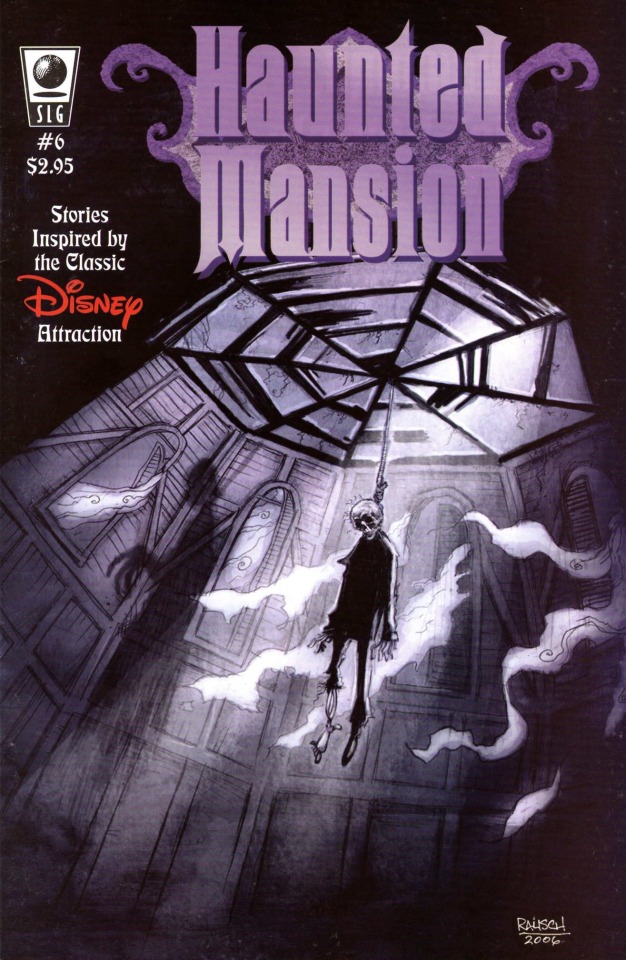
Haunted Mansion #6
#haunted mansion#hanging#suicide#spooky#ghosts#scary#disney#drew rausch#slave labor graphics#comics#00s comics
7 notes
·
View notes
Photo

Kitty Pail by Drew Rausch
#Drew Rausch#kitty pail#trick or treat#candy#halloween#halloween art#horror#horror art#candles#candy apple#candy corn#eyeball#fire#spoopy#spooky#creepy#cartoon#lollipop#black cat
374 notes
·
View notes
Photo

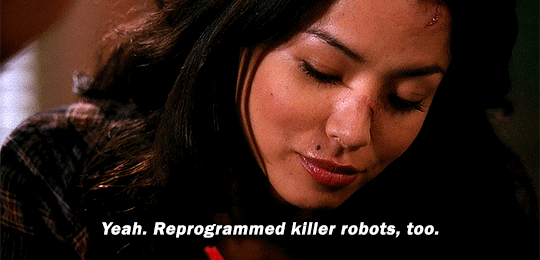


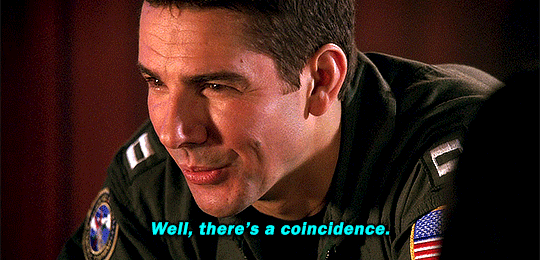



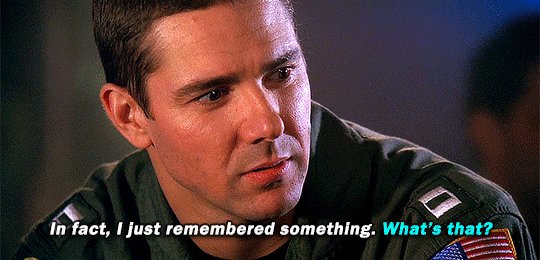

#tsccedit#terminator: the sarah connor chronicles#tscc#stephanie jacobsen#jesse flores#mygraphics#gif#drew rausch#i love she
22 notes
·
View notes
Text



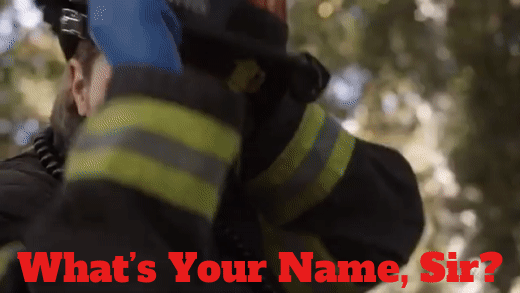
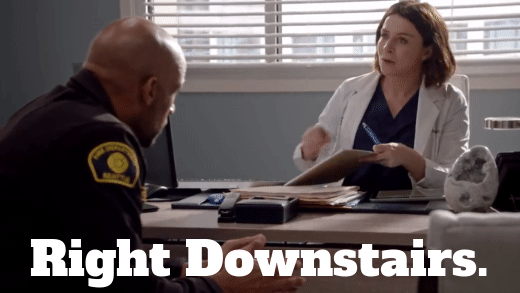


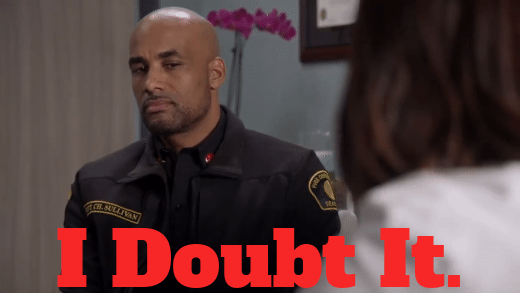

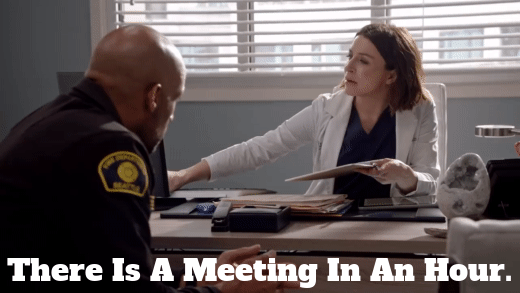
Some gifs I made from Station 19 3x08.
#station 19#station 19 3x08#andy herrera#robert sullivan#travis montgomery#john finch#amelia shepherd#s19edit#station19edit#tvedit#gif#gifs#jaina lee ortiz#boris kodjoe#drew rausch#jay hayden#caterina scorsone
4 notes
·
View notes
